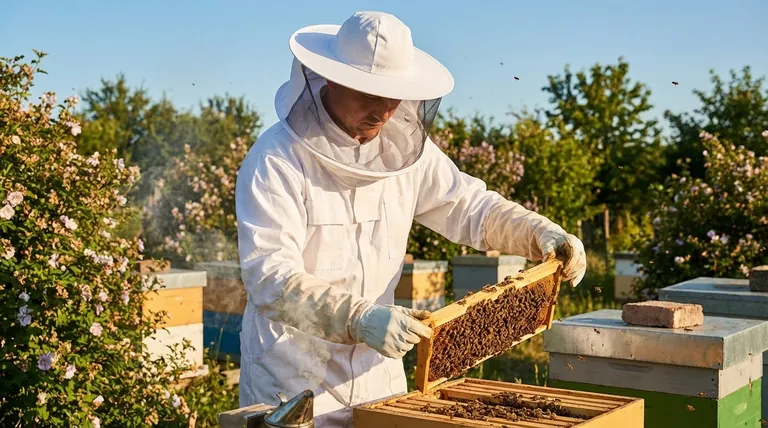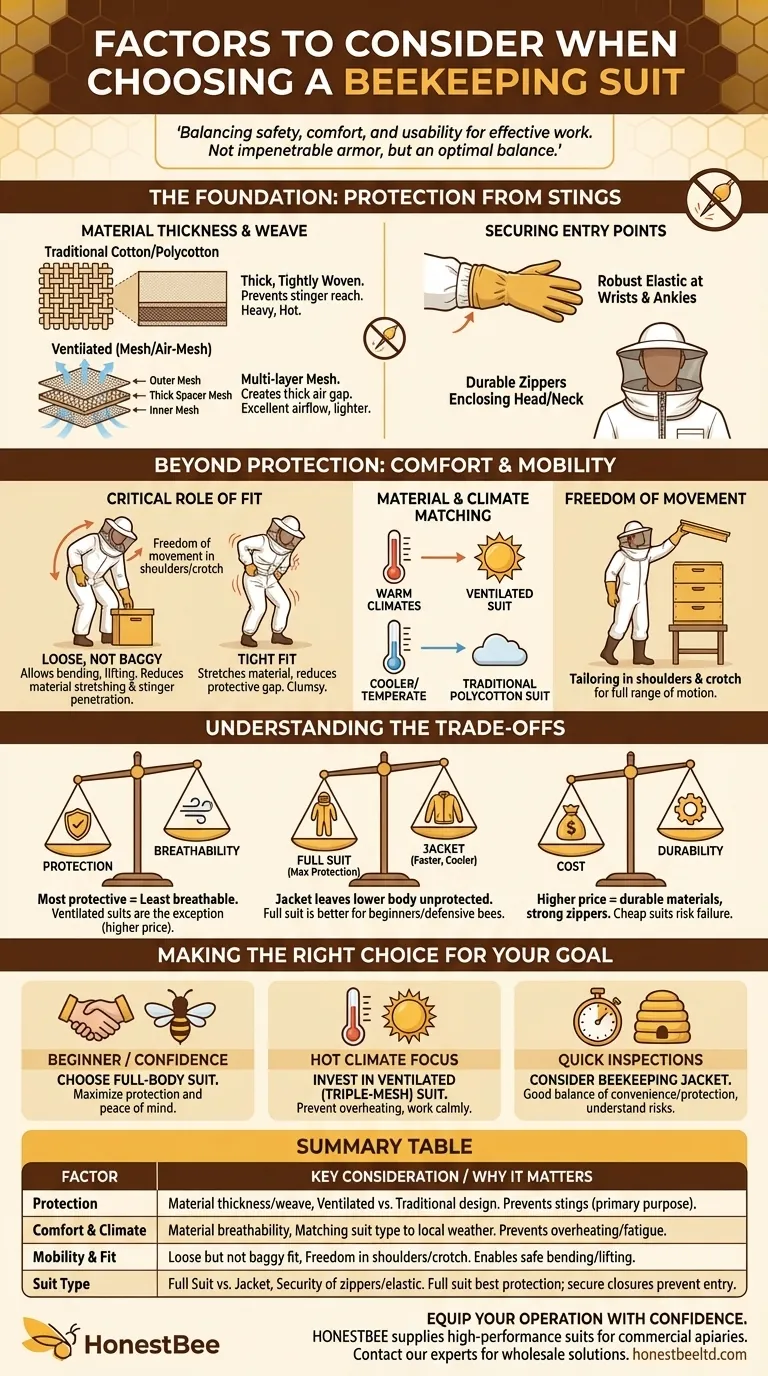At its core, choosing a beekeeping suit is an exercise in balancing safety, comfort, and usability. The most important factors to consider are the level of sting protection, the material and its suitability for your climate, and the overall fit that allows for unrestricted movement. A quality suit is an investment in your confidence and ability to work effectively.
The right beekeeping suit is not about achieving impenetrable armor, but about finding the optimal balance between protection and comfort. This balance allows you to work with your bees calmly and without the distraction of heat or restricted movement.

The Foundation: Protection from Stings
Your primary reason for wearing a suit is to prevent stings. This is achieved through a combination of material, design, and secure closures.
Material Thickness and Weave
Most suits are made from cotton, a polycotton blend, or layered mesh. Traditional cotton or polycotton suits rely on the thickness and tight weave of the fabric to prevent a bee's stinger from reaching your skin.
Thicker materials offer more protection but can be heavy and hot. A polycotton blend often provides a good compromise between the durability of polyester and the breathability of cotton.
Ventilated vs. Traditional Suits
Ventilated suits, often called triple-mesh or air-mesh suits, are a modern alternative. They work by creating a thick layer of air that a stinger cannot cross.
These suits consist of two outer layers of mesh with a thicker, spacer-like mesh in between. This design provides excellent sting protection while allowing for maximum airflow, making them ideal for beekeeping in hot climates.
Securing the Entry Points
Bees will exploit any gap to gain access to your skin. A secure suit must have robust elastic at the wrists and ankles to create a firm seal over your boots and gloves.
The veil's connection to the suit is another critical point. Look for durable zippers that fully enclose the head and neck area, ensuring there are no gaps for curious bees to investigate.
Beyond Protection: Prioritizing Comfort and Mobility
A suit that is overly hot or restrictive can be just as dangerous as one with poor protection, as it can cause you to rush your work.
The Critical Role of Fit
Your suit should be loose but not baggy. A tight fit stretches the material, reducing its protective gap and making it easier for a stinger to penetrate.
Conversely, an excessively large suit can be clumsy, snag on equipment, and make movement difficult. A well-fitting suit allows you to bend, lift, and reach without the fabric pulling tight across your shoulders, back, or knees.
Material and Climate Matching
The material you choose should be dictated by your local climate. Wearing a thick, unventilated cotton suit in a hot, humid region will lead to rapid overheating and fatigue.
For warm climates, a ventilated suit is a superior choice. For cooler, more temperate zones, a traditional polycotton suit may provide sufficient comfort and protection.
Freedom of Movement
Beekeeping involves physical work. You will be bending to lift heavy hive boxes and reaching into awkward positions. Your suit must allow for a full range of motion.
Pay attention to the tailoring in the shoulders and crotch. A well-designed suit provides ample room in these areas to prevent tearing and ensure you can move freely and confidently.
Understanding the Trade-offs
Choosing a suit involves navigating a few key compromises. Understanding them will help you make a more informed decision.
Protection vs. Breathability
This is the central trade-off. The most protective, heavy-duty materials are almost always the least breathable. Ventilated suits are the exception, offering high levels of both protection and airflow, but they come at a higher price point.
Full Suit vs. a Jacket
For quick inspections, some experienced beekeepers opt for a beekeeping jacket. A jacket is faster to put on and cooler to wear.
However, a jacket leaves your lower body unprotected and creates a significant gap at the waist. For beginners, or for anyone working with more defensive bees, a full suit offers far superior protection and peace of mind.
Cost vs. Durability
Higher-priced suits typically use more durable materials, stronger zippers, and reinforced stitching. While a cheaper suit may seem appealing, a failed zipper or a torn seam during a hive inspection can create a dangerous situation. Investing in quality is an investment in reliability and safety.
Making the Right Choice for Your Goal
Your specific needs as a beekeeper should guide your final decision.
- If your primary focus is building confidence as a beginner: Choose a full-body suit with reliable zippers and a secure veil to maximize your protection and peace of mind.
- If your primary focus is working in a hot climate: Invest in a high-quality ventilated (triple-mesh) suit to prevent overheating and ensure you can work calmly.
- If your primary focus is quick, frequent inspections: A well-made beekeeping jacket can offer a good balance of convenience and protection, but understand the risks involved.
Ultimately, the best suit is the one you will wear consistently, allowing you to focus on the health of your hive.
Summary Table:
| Factor | Key Consideration | Why It Matters |
|---|---|---|
| Protection | Material thickness/weave, Ventilated vs. Traditional design | Prevents stings, the primary purpose of the suit |
| Comfort & Climate | Material breathability, Matching suit type to local weather | Prevents overheating and fatigue, allowing for calm work |
| Mobility & Fit | Loose but not baggy fit, Freedom of movement in shoulders/crotch | Enables safe bending and lifting without fabric stretching |
| Suit Type | Full Suit vs. Jacket, Security of zippers and elastic closures | Full suit offers best protection; secure closures prevent bee entry |
Equip Your Operation with Confidence
Choosing the right beekeeping suit is critical for the safety and efficiency of your apiary. At HONESTBEE, we supply commercial apiaries and beekeeping equipment distributors with high-performance suits designed for professional use. Our wholesale-focused operations ensure you get durable, reliable gear that protects your team and enhances productivity.
Let us help you make the right choice. Contact our experts today to discuss your specific needs and explore our range of commercial-grade beekeeping supplies.
Visual Guide

Related Products
- Cotton Beekeeping Suit and Round Hat with Veil Bee Keeper Protective Gear
- White Beekeeping Protective Suit and Hat with Fencing Veil for Beekeepers
- Heavy Duty Cowboy Beekeeper Hat with Visibility Veil Outdoor Professional Beekeeping Protective Gear
- Beekeeper Cowboy Hat and Veil for Beekeeping
- Beekeeping Gloves Goatskin Leather with Long Cotton Sleeve for Beekeepers
People Also Ask
- What are bee suits made of? Choosing the Right Material for Maximum Protection & Comfort
- How should a beekeeping suit be hung to maintain its shape? Protect Your Investment with Proper Storage
- Why is white the predominant color in bee suit designs? | Key to Hive Calm & Beekeeper Safety
- What is recommended for beginners in beekeeping regarding protective clothing? A Complete Safety Guide for New Beekeepers
- What are the benefits of a fully ventilated beekeeping suit? Stay Cool and Protected in Hot Climates



















